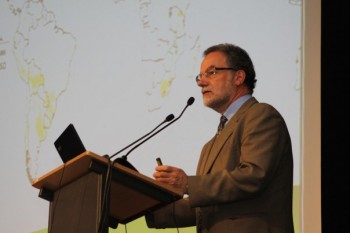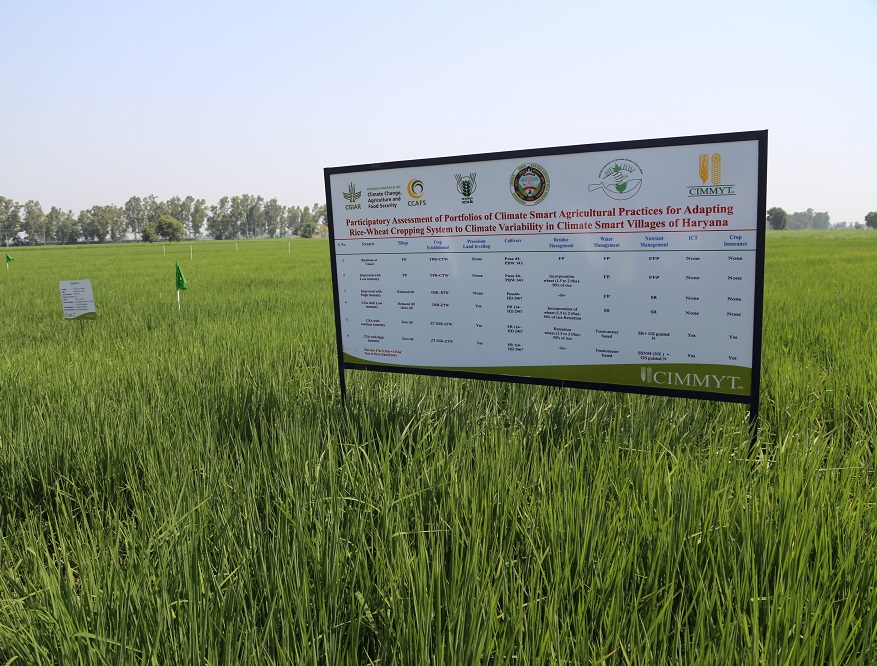
EL BATAN, Mexico (CIMMYT) — Hans Braun, director of the Global Wheat Program at the International Maize and Wheat Improvement Center (CIMMYT), gestures toward an expansive field of green wheat shimmering in the hot sunlight outside his office.
“If we don’t prepare crops resilient to heat and drought, the effects of climate change will increase the risk of worldwide famine and conflict,” he explained. “That’s why CIMMYT is part of an international research program to develop new climate change-resistant varieties.”
As the global population grows from a current 7 billion to a projected 9.6 billion by 2050, wheat breeders involved in the battle to ensure food security face many challenges.
Already, U.N. food agencies estimate that at least 805 million people do not get enough food and that more than 2 billion suffer from micronutrient deficiency, or “hidden hunger.”
Globally, wheat provides 20 percent of the world’s daily protein and calories, according to the Wheat Initiative. Wheat production must grow 60 percent over the next 35 years to keep pace with demand, statistics from the Food and Agriculture Organization of the United Nations show – an achievable goal only if wheat yields increase from the current level of below 1 percent annually to at least 1.7 percent per year.
The scientists that Braun leads are on the front lines – tackling the climate change threat in laboratories and at wheat research stations throughout Mexico and in 13 other countries.
LIFE-SAVING GRAIN
Wheat is vital to global food security. In particular, since CIMMYT scientist Norman Borlaug, who died in 2009 at age 95, led efforts to develop semi-dwarf wheat varieties in the mid-20th century that helped save more than 1 billion lives in Pakistan, India and other areas of the developing world.
Borlaug started work on wheat improvement in the mid-1940s in Mexico – where CIMMYT is headquartered near Mexico City. The country became self-sufficient in wheat production in the early 1960s.
Borlaug was awarded the Nobel Peace Prize in 1970 for his work, and in his acceptance speech paid tribute to the “army of hunger fighters” with whom he had worked.
However, in contemporary times, some critics have cast a shadow over his work, questioning the altruistic aims of the project that became widely known as the Green Revolution.
They argue that the modern high-yielding crop varieties did not help poor farmers, but caused environmental damage through overuse of fertilizers, water resources and the degradation of soils.
Other condemnations include claims that food scarcity is a mere political construct, that food provision has helped governments suppress disgruntled masses and that vast wheat mono-croplands compromise agricultural and wild biodiversity.
However, a 2003 report in “Science” magazine analyzed the overall impact of the Green Revolution in the 20th Century. The authors, economists from Yale University and Williams College, found that without the long-term increase in food crop productivity and lower food prices resulting from the Green Revolution, the world would have experienced “a human welfare crisis.”
“Caloric intake per capita in the developing world would have been 13.3 to 14.4 percent lower and the proportion of children malnourished would have been from 6.1 to 7.9 percent higher,” authors Robert Evanson and Douglas Gollen wrote.
“Put in perspective, this suggests that the Green Revolution succeeded in raising the health status of 32 to 42 million preschool children. Infant and child mortality would have been considerably higher in developing countries as well.”
Braun acknowledges certain points made by critics of the Green Revolution, but asks how else developing countries would have met the food demands of their rapidly-expanding populations with less environmental impact.
“It’s very easy to look back 50 years and criticize,” Braun said. “People forget that at the time, new farm technologies were an incredible success. We have to put it into context – saving hundreds of millions of lives from starvation was the priority and the Green Revolution did just that.”
CLIMATE-RESILIENT WHEAT
Fast-forward and today much of CIMMYT’s current work remains steadily focused on improving wheat yields, but now with an emphasis on ensuring sustainable productivity and reducing agriculture’s environmental footprint.
Scientists are engaged in an international five-year project to develop climate-resilient wheat. They estimate that in tropical and sub-tropical regions, wheat yields will decrease by 10 percent for each 1-degree rise in minimum night-time temperature, which means that production levels could decline by 30 percent in South Asia. About 20 percent of the world’s wheat is produced in the region.
CIMMYT is collaborating with Kansas State University, Cornell University and the U.S. Department of Agriculture on the project, which is funded by the U.S. Agency for International Development (USAID) as part of Feed the Future, the U.S. government’s global hunger and food security initiative.
Field evaluations are conducted in Mexico, Pakistan and at the Borlaug Institute for South Asia (BISA) in India.
BOOSTING INFRASTRUCTURE
According to Braun, one of the biggest challenges over the next 30 years is to develop better production systems in addition to resource-efficient crops.
For example, a great deal of water is used in food production and demand can and should be cut in half, he said. “We need to focus on sustainable intensification in ways that won’t overuse natural resources.”
To aid in these efforts, CIMMYT has developed international research programs on conservation and precision agriculture.
In conservation agriculture, farmers reduce or stop tilling the soil, leaving crop residues on the surface of the field and rotate crops to sustainably increase productivity. Precision agriculture involves such technologies as light sensors to determine crop vigor and gauge nitrogen fertilizer dosages to determine exactly what plants need.
“This reduces nitrate runoff into waterways and greenhouse gas emissions,” Braun explained. CIMMYT and its partners are also breeding wheat lines that are better at taking up and using fertilizer.
“Wheat in developing countries currently uses only 30 percent of the fertilizer applied,” he said. “There are promising options to double that rate, but developing and deploying them require significant investments.”
“I’m very optimistic that we can produce 60 to 70 percent more wheat to meet demand – society is beginning to recognize that food production is one of humanity’s biggest challenges – today and in the future,” Braun summarized.
“We have or can develop the technologies needed, but politicians must recognize that investment in agriculture is not a problem, it’s a solution – the longer we wait the bigger the potential problems and challenges we face.”
Braun continued, “We also need policymakers to reach agreement that global climate change is a big problem that absolutely must be addressed so that we can gain access to sufficient resources and more fully develop appropriate technologies.”

 Climate adaptation and mitigation
Climate adaptation and mitigation